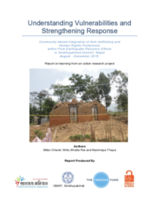This report examines the effects the 2015 Nepal earthquakes had on vulnerable populations. It lists several concerns faced since the earthquake, which include the thousands of people who have lost their homes and children left unaccompanied. These groups are considered ripe targets for human traffickers. Researchers evaluate the posed risks to children, women, and marginalized groups. The report highlights the workshops and trainings that were held to protect vulnerable populations.
With the help of key informants, training workshops, and visits to the Sindhupalchok district, researchers were able to determine that there were increased vulnerabilities to human trafficking. Research also determined that there were significant risk markers, including lack of relief supplies and unsafe shelters.
As pertaining to unaccompanied children, researchers determined many challenges. A few of them include: managing and continuing education; ensuring adult protection and guardianship; and protecting children from being automatically moved to child care homes. Also, community-based child care systems are not established in many of these areas.
Training workshops allowed participants to act as advocates for several children within the region. Workshops allowed hundreds of children to be saved from adverse conditions. Many children were referred to child protective services and organizations.
This report determines that future efforts be in concert with frontline local NGO workers living within the affected communities about the risks of trafficking, violence and exploitation, and about the protection needs of unaccompanied and separated children.

